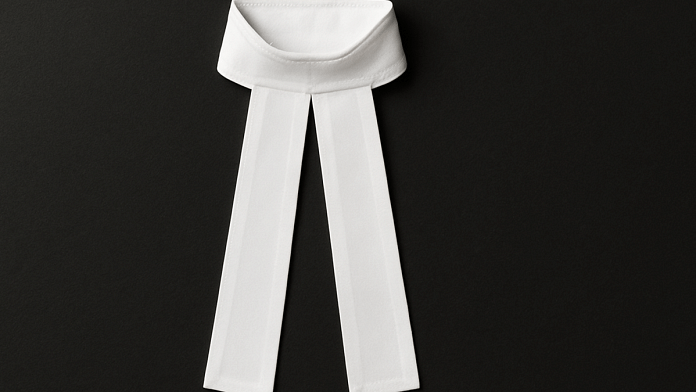Thank you dear subscribers, we are overwhelmed with your response.
Your Turn is a unique section from ThePrint featuring points of view from its subscribers. If you are a subscriber, have a point of view, please send it to us. If not, do subscribe here: https://theprint.in/subscribe/
For a newly enrolled advocate, the white bands are more than just formal attire; they are a badge of honour, a token of tradition, and the quiet beginning of a long, solemn journey through the world of law. They are not stitched with mere thread but woven with the hopes of generations, the resilience of justice, and the silent pride of entering a hallowed fraternity.
There’s an old charm in the moment when a senior ties the first bands for their junior. It’s often unceremonious, done in a quiet corner of a court corridor or chambers, but that moment brims with significance. It’s not just about helping with attire, but about an unspoken passing of a legacy. In the gleam of the junior’s eyes lies the hope that a touch of their senior’s wisdom, strength, and conviction will travel through that fabric.
The black coat, gown, and white bands, mandated by the Advocates Act, 1961 and Bar Council Rules, are more than uniform; they symbolise solemnity, discipline, and the distinct role of lawyers in the judiciary. Yet, their meaning goes deeper than mere compliance.
I recall an incident from my early years that left a lasting impression and revealed the true value of the bands. It took place in the hallowed courtroom of the Delhi High Court, where a renowned senior advocate, known for his compelling arguments, rushed in and began speaking with full conviction.
The Hon’ble Judge, however, interrupted him calmly: “My advocate, I cannot see you.” Perplexed, the advocate continued, speaking even louder, only to be interrupted again: “I still cannot see you.” The courtroom was confused, heads turned, eyebrows raised. The advocate, now clearly baffled, respectfully asked, “My Lords, I fail to understand.” To which the Judge, with graceful dignity, replied: “We cannot see you because you are not wearing your bands.”
In that moment, everything paused. The power of attire was unmistakable. That small omission, the missing white bands, rendered him ‘invisible’ to the court. Regardless of his stature or arguments, without the bands, he had no formal presence before the bench. It was a subtle yet powerful reminder: the bands are not mere accessories, but symbols of an advocate’s authority, identity, and duty to the court.
Many view the bands as simply a British legal tradition, but this opens a valuable opportunity to uncover their deeper spiritual and symbolic meaning, deepening our appreciation of their role in the law.
Few realise that the lawyer’s bands, white, starched strips worn at the collar, hold deep symbolic meaning that traces thousands of years back to Moses, the first great lawgiver in biblical history.
Though Moses did not create or wear the bands himself, his role as the divine lawgiver has deeply influenced their symbolism. According to the Book of Exodus, Moses received the Ten Commandments on two stone tablets from God. The two white bands worn by lawyers are believed to represent these tablets, symbolising the sacred origins of law and the idea that justice is not only a civil duty but also a moral one, rooted in divine authority.
The Ten Commandments profoundly influence modern law, reflecting core principles of justice, fairness, and human dignity. They remind us that legal practice is not just a profession, but a pursuit rooted in higher moral ideals. Here’s how they connect to legal practice:
- Respect for Life and Property: Commandments like “You shall not murder” and “You shall not steal” align with laws protecting individual rights and property, upheld by criminal lawyers seeking justice.
- Truth and Justice: “You shall not bear false witness” reflects the legal duty of truthfulness; lawyers must seek truth, as perjury is a serious offence.
- Protection of Family and Social Order: Commandments on marriage and family, like “You shall not commit adultery” and “Honour your father and your mother,” underscore family stability, often central to family law cases.
- Moral Foundations for Law: The Ten Commandments provide a moral code influencing many legal systems, guiding lawyers in their pursuit of justice and human rights.
In the British legal tradition, later adopted by many common law countries like India, bands became standard courtroom attire for judges and barristers. Their association with the Mosaic tablets eventually gave this formal wear a symbolic moral meaning.
When a lawyer dons the bands, they wear not just a uniform but a timeless legacy, one that echoes back to Moses and the Ten Commandments. These bands are more than fabric; they embody a sacred duty to uphold justice, truth, and moral integrity. They remind us that the law is not merely a profession, but a solemn calling.
Let us honour this legacy, pass it to future generations, and remember that in court, we speak with the weight of history and purpose woven into every fold of these bands.
These pieces are being published as they have been received – they have not been edited/fact-checked by ThePrint.


